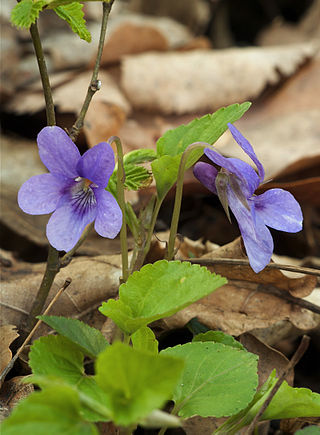
Viola is a genus of flowering plants in the violet family Violaceae. It is the largest genus in the family, containing between 525 and 600 species. Most species are found in the temperate Northern Hemisphere; however, some are also found in widely divergent areas such as Hawaii, Australasia, and the Andes.

Bulbophyllum is a genus of mostly epiphytic and lithophytic orchids in the family Orchidaceae. It is the largest genus in the orchid family and one of the largest genera of flowering plants with more than 2,000 species, exceeded in number only by Astragalus. These orchids are found in diverse habitats throughout most of the warmer parts of the world including Africa, southern Asia, Latin America, the West Indies, and various islands in the Indian and Pacific Oceans. Orchids in this genus have thread-like or fibrous roots that creep over the surface of trees or rocks or hang from branches. The stem is divided into a rhizome and a pseudobulb, a feature that distinguished this genus from Dendrobium. There is usually only a single leaf at the top of the pseudobulb and from one to many flowers are arranged along an unbranched flowering stem that arises from the base of the pseudobulb. Several attempts have been made to separate Bulbophyllum into smaller genera, but most have not been accepted by the World Checklist of Selected Plant Families.

Cymbidium, commonly known as boat orchids, is a genus of evergreen flowering plants in the orchid family Orchidaceae. Orchids in this genus are epiphytic, lithophytic, terrestrial or rarely leafless saprophytic herbs usually with pseudobulbs. There are usually between three and twelve leaves arranged in two ranks on each pseudobulb or shoot and lasting for several years. From one to a large number of flowers are arranged on an unbranched flowering stem arising from the base of the pseudobulb. The sepals and petals are all free from and similar to each other. The labellum is significantly different from the other petals and the sepals and has three lobes. There are about fifty-five species and sixteen further natural hybrids occurring in the wild from tropical and subtropical Asia to Australia. Cymbidiums are well known in horticulture and many cultivars have been developed.

Primula sect. Dodecatheon is a section of herbaceous flowering plants in the family Primulaceae. Primula species in this section were formerly placed in a separate genus, Dodecatheon. The species have basal clumps of leaves and nodding flowers that are produced at the top of tall stems rising from where the leaves join the crown. The genus is largely confined to North America and part of northeastern Siberia. Common names include shooting star, American cowslip, mosquito bills, mad violets, and sailor caps. A few species are grown in gardens for their showy and unique flower display.

Veronica is the largest genus in the flowering plant family Plantaginaceae, with about 500 species. It was formerly classified in the family Scrophulariaceae. Common names include speedwell, bird's eye, and gypsyweed.
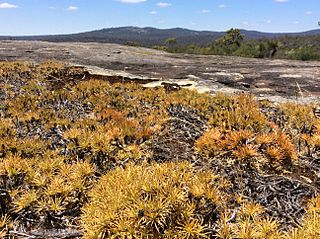
Boryaceae is a family of highly drought-tolerant flowering plants native to Australia, placed in the order Asparagales of the monocots. The family includes two genera, with twelve species in total in Australia.

Bulbophyllum teretifolium is a species of plant in the family Orchidaceae. It is an epiphyte with cylindrical leaves and up to about forty small, white and purplish flowers and is endemic to Cameroon. Its natural habitat is subtropical or tropical, moist montane forests, where it is threatened by habitat loss.
James ('Jim') Boughtwood Comber was born at Garlieston, Scotland, into a famous horticultural family. His father was the noted collector and lily breeder Harold Frederick Comber ALS, while his grandfather, James Comber VMH was Head Gardener at Nymans. His brother Richard gained a PhD in plant biochemistry. from Southampton University in 1955. His sister, Mary Comber-Miles, became the resident botanical artist at the University of British Columbia.
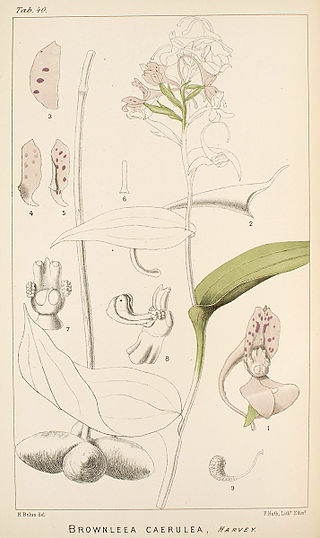
Brownleea is a genus of flowering plants from the orchid family, Orchidaceae native to Africa and Madagascar. Eight species are known.
- Brownleea coeruleaHarv. ex Lindl.
- Brownleea galpiniiBolus
- Brownleea graminicolaMcMurtry
- Brownleea macrocerasSond.
- Brownleea maculataP.J.Cribb
- Brownleea mulanjiensisH.P.Linder
- Brownleea parvifloraHarv. ex Lindl.
- Brownleea recurvataSond.
Bulbophyllum nocturnum is a species of epiphytic orchid that grows in New Britain. It was described in 2011, and is the first species of orchid known to consistently flower during the night, and close its flowers during the day.

Jean Marie Bosser, sometimes listed as Jean-Michel Bosser was a French botanist and agricultural engineer who worked extensively in Madagascar and Mauritius.

Dendrobieae is a tribe in the subfamily Epidendroideae, in the family Orchidaceae. The Dendrobieae are mostly tropical, epiphytic orchids which contain pseudobulbs.
Paralophia is a genus of orchids endemic to Madagascar. It contains two known species:
André Schuiteman is a Dutch botanist in the Royal Botanic Gardens, Kew in London, United Kingdom, where he is the Research Leader for Asia in Plant Identification and Naming. Schuitemania, a genus of orchid, was named in his honour.

Allium is a genus of monocotyledonous flowering plants with hundreds of species, including the cultivated onion, garlic, scallion, shallot, leek, and chives. The generic name Allium is the Latin word for garlic, and the type species for the genus is Allium sativum which means "cultivated garlic".

Bulbophyllum conspectum is a species of orchid in the genus Bulbophyllum.
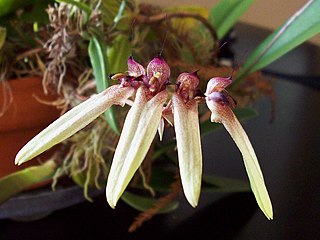
Bulbophyllum sect. Cirrhopetalum is a section of the genus Bulbophyllum. The taxon name comes from Latin cirrus (fringe) and Greek petalon (petal), hence meaning fringed-petaled.
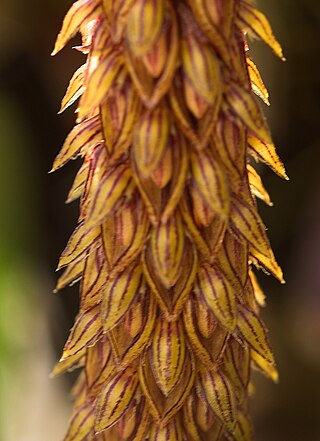
Bulbophyllum sect. Racemosae is a section of the genus Bulbophyllum.

Bulbophyllum sect. Lepidorhiza is a section of the genus Bulbophyllum.

Dendrobium section Spatulata is a section of the genus Dendrobium.

















